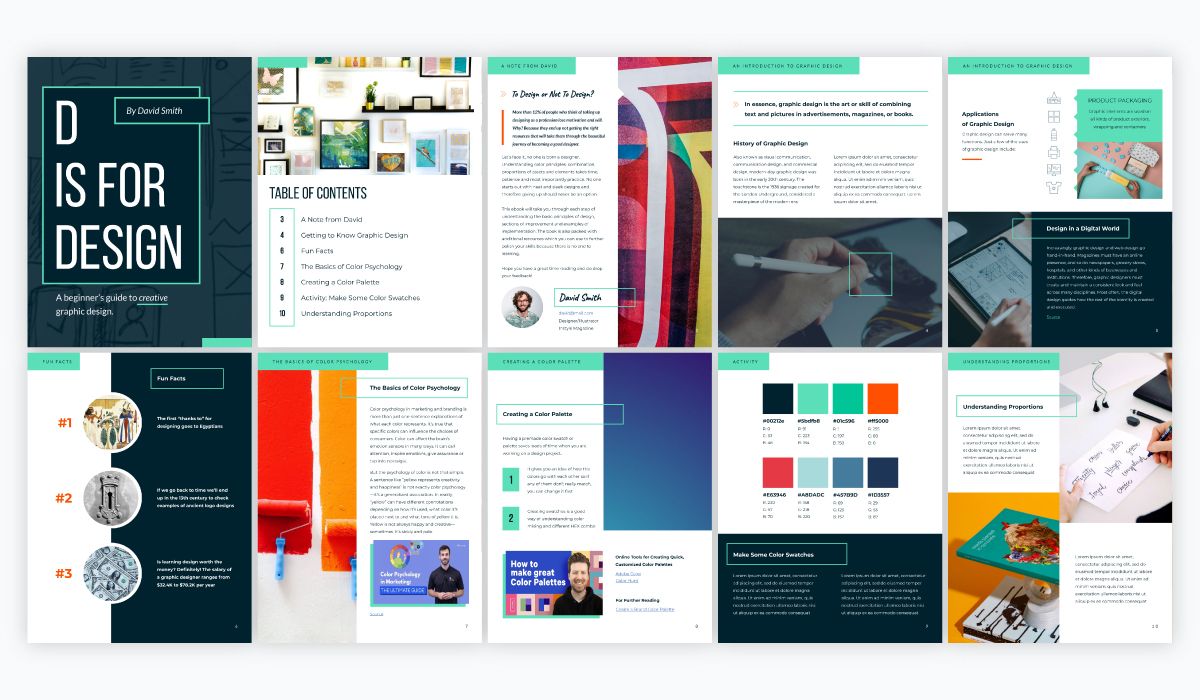Introduction
Welcome to the wonderful world of eBook writing! Writing an eBook can be an exciting and fulfilling endeavor that allows you to share your knowledge and expertise with a wide audience. Whether you want to create a comprehensive guide, a captivating story, or a practical self-help book, the possibilities are endless.
But you may be wondering, is it really possible to write an eBook in just seven days? The answer is yes, it is indeed achievable with careful planning and dedication. In this guide, we will walk you through the step-by-step process of writing an eBook in just one week. By following this roadmap, you’ll be able to efficiently create a high-quality eBook that will resonate with your readers.
Before we dive into the specifics of each day, let’s address a common concern: quality versus quantity. While the goal is to complete your eBook within a week, it’s important to prioritize quality. You want to deliver a valuable and engaging reading experience for your audience. So, keep in mind that your primary focus should be on producing a well-written eBook that provides value rather than rushing through the process.
Additionally, during this seven-day journey, we’ll focus on the writing aspect of eBook creation. Although it’s crucially important, we won’t delve into the technical aspects of formatting, publishing, and marketing in this guide. However, we’ll touch on these briefly to provide you with a well-rounded understanding of the eBook creation process.
So, are you ready to embark on this exciting writing adventure? Let’s get started with Day 1: Choosing a Topic, where we’ll explore strategies for selecting the perfect subject for your eBook.
Day 1: Choosing a Topic
One of the most critical steps in writing an eBook is selecting a captivating and relevant topic. Your topic will determine the direction and focus of your eBook, so it’s essential to choose wisely. Here are some steps to guide you in choosing the perfect topic:
- Identify your expertise: Consider your areas of knowledge and expertise. What are you passionate about? What unique experiences or skills do you possess? Identifying your expertise will help you choose a topic that you can confidently write about.
- Do market research: Survey the market to understand current trends and popular topics. Look for gaps or areas where your expertise can fill a need. This will help you ensure that your eBook will have an interested and engaged audience.
- Consider your target audience: Who do you want to reach with your eBook? Define your target audience and think about their interests, needs, and pain points. Your topic should align with their preferences and provide valuable solutions.
- Brainstorm and narrow down: Take some time to brainstorm a list of potential topics. Write down any ideas that come to mind. Then, evaluate each idea based on criteria such as relevance, market demand, and your own passion. Narrow down your options to one or two strong contenders.
- Validate your topic: Once you have a few potential topics, conduct further research to validate their viability. Look for keywords related to your topic and check their search volume to gauge the potential interest. Additionally, explore online forums, social media groups, and industry-specific communities to see if there’s a demand for your chosen topic.
By following these steps, you’ll be able to choose a topic that aligns with your expertise, resonates with your target audience, and has potential market demand. Remember, selecting the right topic sets a strong foundation for the success of your eBook. Now that you have chosen your topic, it’s time to move on to Day 2: Researching and Outlining, where we’ll dive into the initial stages of creating your eBook.
Day 2: Researching and Outlining
Now that you have a clear topic for your eBook, it’s time to dive into the research and outlining phase. This crucial step lays the foundation for your content and ensures that your eBook is well-structured and organized. Here’s how you can make the most of Day 2:
1. Conduct thorough research: Start by gathering information and resources related to your chosen topic. This could include books, articles, scholarly papers, interviews, or online resources. Take notes and extract key points, arguments, and examples that you’d like to include in your eBook. Remember, it’s essential to provide accurate and reliable information to add value to your readers’ experience.
2. Organize your information: Once you have gathered your research materials, it’s time to organize them in a logical and coherent structure. Create an outline for your eBook, dividing it into chapters or sections. In each section, outline the main ideas and supporting points that you’ll expand upon in your writing. This will help you maintain a clear and systematic flow throughout your eBook.
3. Develop your unique angle: As you delve deeper into your research, try to develop a unique angle or perspective on your topic. Think about what sets your eBook apart from others in the market. How can you provide fresh insights or unique solutions to the reader? Differentiating yourself will make your eBook more compelling and valuable to the audience.
4. Consider your target audience: Throughout the outlining process, keep your target audience in mind. Think about their level of knowledge and their specific needs or challenges. Tailor your outline and content to address their concerns and provide practical solutions. This will resonate with your readers and make your eBook more relevant and engaging.
5. Revise and refine: Once you have completed your initial outline, take some time to review and refine it. Ensure that the flow of ideas makes sense, and that each section logically connects to the next. Rearrange or reorganize any sections if needed. The goal is to create a comprehensive and well-structured outline that will guide you through the writing process.
By dedicating Day 2 to research and outlining, you’ll lay a strong foundation for your eBook. You’ll have a clear path to follow and a solid understanding of the content you want to deliver. Now, it’s time to move on to Day 3: Writing the First Draft, where we’ll bring your ideas to life and start crafting your eBook.
Day 3: Writing the First Draft
Congratulations! You’ve completed the research and outlining phase, and now it’s time to dive into writing the first draft of your eBook. Day 3 is all about bringing your ideas to life and creating the initial framework for your eBook. Here are some tips to help you make the most of this important day:
1. Set a writing schedule: Establish a dedicated time and place for writing. Create a schedule that works best for you, whether it’s in the morning, afternoon, or evening. Set a specific word count or time goal for each writing session, and commit to it. Consistency is key to making progress and staying motivated.
2. Focus on writing, not editing: During the first draft, try to avoid the temptation to edit as you go. The goal is to get your ideas down on paper without worrying too much about perfection or grammar. Let your creativity flow and allow yourself to make mistakes. Remember, you can always revise and edit later.
3. Write in chunks: Instead of overwhelming yourself with the entire eBook, break it down into manageable chunks. Focus on one chapter or section at a time. This approach helps maintain your focus and motivation as you meet smaller writing milestones throughout the day.
4. Embrace your unique voice: Let your personality shine through your writing. Use a tone and style that resonate with your target audience. Be authentic and strive to connect with the reader on a personal level. Your voice and perspective on the topic will make your eBook stand out from others.
5. Use supportive tools: Take advantage of technology to enhance your writing process. Utilize writing software or apps that offer distraction-free environments and helpful features like spell-checking and word count tracking. These tools can improve your efficiency and make the writing process smoother.
6. Take breaks and stay refreshed: Writing can be mentally demanding, so remember to take regular breaks. Use these breaks to recharge, stretch, or engage in activities that inspire you. By maintaining a balance between focused writing sessions and rejuvenating breaks, you’ll keep your creativity and motivation levels high.
By the end of Day 3, you should have a solid first draft of your eBook. Congratulations on reaching this milestone! Now, take a moment to appreciate your progress and get ready for Day 4: Editing and Proofreading, where we’ll polish your content and ensure it’s error-free and reader-friendly.
Day 4: Editing and Proofreading
Now that you have a completed first draft of your eBook, it’s time to shift gears and focus on editing and proofreading. Day 4 is dedicated to refining your content, improving the flow and clarity of your writing, and ensuring that your eBook is error-free before it reaches your readers. Here’s how you can make the most of this editing and proofreading stage:
1. Take a break: Before diving into the editing process, it’s essential to give yourself some distance from your writing. Take a short break, walk away from your eBook, and return with fresh eyes. This break will help you approach the editing process with a more critical and objective perspective.
2. Review for clarity and coherence: Start by reviewing the overall structure and organization of your eBook. Check the flow of ideas, transitions between sections, and the logical progression of information. Make any necessary revisions to ensure that your message is clear and cohesive.
3. Check grammar and punctuation: Pay attention to grammar, punctuation, and sentence structure. Look out for common mistakes such as typos, misspellings, and misplaced commas. Use grammar-checking tools or ask a trusted friend or colleague to proofread your eBook for an extra set of eyes.
4. Refine your writing style: As you edit, focus on improving your writing style. Ensure that your sentences are concise and engaging. Consider varying sentence lengths and structures to create a dynamic reading experience. Eliminate repetitive phrases or clichés to maintain freshness in your writing.
5. Trim unnecessary content: It’s important to keep your eBook concise and focused. Look for any repetitive or irrelevant information that can be removed. Trim down lengthy paragraphs or sections that may distract or overwhelm the reader. Remember, quality over quantity is key.
6. Seek feedback: Consider sharing your edited draft with others and ask for feedback. Constructive criticism can help you identify areas for improvement and gain different perspectives on your content. Be open to suggestions and willing to make necessary changes to enhance the overall quality of your eBook.
By the end of Day 4, your eBook should be polished and ready for the next stage. Editing and proofreading are crucial steps in delivering a professional and well-crafted eBook. Now, you can confidently move on to Day 5: Designing a Cover and Formatting, where you’ll bring your eBook to life visually and prepare it for publication.
Day 5: Designing a Cover and Formatting
Congratulations on reaching Day 5 of your eBook creation journey! This day is all about designing a captivating cover and formatting your eBook for a visually appealing and reader-friendly experience. Let’s dive into the key steps for making your eBook visually appealing:
1. Create an eye-catching cover: The cover is the first thing readers see, so it needs to grab their attention. Consider hiring a professional designer or utilize design software to create a visually appealing cover that aligns with your eBook’s topic and genre. Use high-quality images, captivating typography, and intriguing color schemes to make your cover stand out.
2. Format your eBook: Formatting is crucial for ensuring a seamless reading experience. Use consistent font styles and sizes throughout your eBook. Break up your content into easily digestible paragraphs and sections. Consider using headings, subheadings, and bullet points to enhance readability. Remember to check the compatibility of your formatting across various eReader devices and software.
3. Incorporate images and visuals: If your eBook contains images or visuals, make sure to optimize and format them appropriately. Resize and compress images to maintain a balance between quality and file size. Ensure that all visuals are relevant and enhance the understanding of your content.
4. Add table of contents and navigation: Include a table of contents at the beginning of your eBook to help readers navigate through the content easily. Hyperlink each section or chapter to its corresponding page, allowing readers to jump directly to the desired section with a single click.
5. Test your eBook: Before finalizing the formatting, it’s essential to test your eBook on different eReader devices and software. Pay attention to any formatting issues, such as text spacing, alignment, or image display. Make the necessary adjustments to ensure that your eBook looks consistent and professional across various platforms.
6. Consider eBook specific features: Take advantage of eBook-specific features such as hyperlinks, interactive elements, and multimedia (if applicable). Hyperlink relevant keywords or external resources to provide additional value to readers. If your eBook allows for multimedia integration, consider adding videos or audio elements to enrich the reader experience.
By the end of Day 5, your eBook will have a visually appealing cover, well-formatted content, and enhanced readability. With these elements in place, you’re one step closer to publishing your eBook. Now it’s time to gear up for Day 6: Publishing and Marketing, where we’ll explore the necessary steps to bring your eBook to the world!
Day 6: Publishing and Marketing
Welcome to Day 6 of your eBook creation journey! Now that your eBook is polished and well-formatted, it’s time to focus on the crucial steps of publishing and marketing. This is where you get to share your masterpiece with the world. Let’s explore the key actions to take on Day 6:
1. Choose a publishing platform: Research different eBook publishing platforms and select the one that aligns with your goals and target audience. Popular options include Amazon Kindle Direct Publishing (KDP), Smashwords, and Apple Books. Each platform has its own unique features, so choose the one that best suits your needs.
2. Format for publication: Ensure your eBook meets the specific formatting guidelines of your chosen publishing platform. Pay attention to file formats, image resolutions, and any other specifications required. Take the time to carefully convert your eBook into the required format to ensure a seamless publishing process.
3. Create a compelling book description: Craft a captivating book description that entices readers to click and learn more about your eBook. Clearly communicate the value and benefits readers will gain from reading your eBook. Use persuasive language and include keywords to improve visibility in search results.
4. Plan your marketing strategy: Develop a marketing strategy to promote your eBook and reach your target audience. This may include utilizing social media platforms, creating a website or blog, guest posting on relevant blogs, engaging in email marketing, or running promotional campaigns. Consider leveraging both organic and paid marketing tactics for maximum exposure.
5. Leverage your network: Reach out to your existing network of friends, family, colleagues, and social media contacts who may be interested in your eBook. Ask for their support in spreading the word, leaving reviews, or sharing your promotional materials. Word of mouth can be a powerful marketing tool.
6. Seek reviews and testimonials: Positive reviews and testimonials help build trust and credibility for your eBook. Reach out to readers who have purchased or received advanced copies of your eBook and kindly request their honest feedback. Encourage them to leave reviews on relevant platforms, such as Amazon or Goodreads.
By focusing on publishing and marketing efforts on Day 6, you’ll be laying the groundwork for the success of your eBook. Remember to be proactive, persistent, and creative in your promotional activities. Now, take a deep breath and get ready for the final day of your eBook creation journey – Day 7: Launching and Promoting!
Day 7: Launching and Promoting
Congratulations, you’ve made it to Day 7 – the final day of your eBook creation journey! On this important day, it’s time to officially launch and promote your eBook to the world. Here are the key steps to take for a successful launch:
1. Set your launch date: Choose a specific date for your eBook launch and mark it on your calendar. This will help create a sense of urgency and enable you to plan your promotional activities around the launch day.
2. Build anticipation: Start creating buzz and generating excitement about your eBook before the launch. Tease your audience with sneak peeks, excerpts, or behind-the-scenes content on your website or social media platforms. Engage with your audience and encourage them to share their anticipation for your eBook.
3. Launch announcement: On the day of the launch, make an official announcement across your various channels. Craft an engaging message that highlights the key features and benefits of your eBook. Include a call-to-action for your audience to purchase or download your eBook.
4. Leverage your platforms: Utilize your website, blog, social media platforms, and email marketing to promote your eBook. Create compelling content related to your eBook’s topic and share it with your audience. Engage with comments, questions, and feedback to foster a positive relationship with your readers.
5. Offer promotions or incentives: Consider offering limited-time promotions, discounts, or bonuses to encourage readers to purchase or download your eBook. This can create a sense of urgency and increase the likelihood of gaining new readers during the launch period.
6. Collaborate with influencers or bloggers: Reach out to influencers or bloggers within your niche who may be interested in your eBook. Offer them a free copy in exchange for a review or feature on their platform. This can significantly expand your reach and credibility.
7. Engage with your readers: Once your eBook is out in the world, actively engage with your readers. Respond to reviews, comments, and messages. Encourage readers to leave honest reviews on platforms like Amazon or Goodreads, as positive reviews can greatly impact the success of your eBook.
Remember, the launch is just the beginning of your eBook’s journey. Continue promoting and marketing your eBook even after the launch to maintain momentum and attract new readers. Stay connected with your audience, and explore additional opportunities for visibility and growth.
Now that you’ve reached the final day of your eBook creation journey, it’s time to celebrate your hard work and dedication. Congratulations on completing your eBook and launching it into the world! Enjoy this exciting phase and embrace the opportunities that come with being a published author.
Conclusion
Congratulations on completing your eBook creation journey! You’ve navigated through the seven crucial days of selecting a topic, researching, writing, editing, formatting, and promoting your eBook. Your hard work, dedication, and passion have led you to this point, and now you have a finished eBook ready to be shared with the world.
Writing an eBook in just seven days is no small feat, but with careful planning, organization, and focus, you’ve accomplished it. Remember that the process of creating an eBook extends beyond these seven days. Publishing and promoting your eBook may require additional time and efforts. Embrace the ongoing journey and continue to refine and optimize your eBook based on reader feedback and market trends.
Your eBook is a valuable asset that showcases your expertise, creativity, and unique perspective. It holds the potential to impact, inspire, and provide valuable insights to your readers. Use your eBook as a platform to connect with your audience, establish your authority in your niche, and build a loyal readership.
As you move forward, keep in mind that writing and self-publishing an eBook is a continuous learning experience. Embrace opportunities for growth, stay open to feedback, and never stop honing your craft. The world of eBooks offers endless possibilities, whether it’s expanding your eBook series, exploring different genres, or repurposing your content for other formats.
Lastly, don’t forget to celebrate your accomplishment! Take a moment to acknowledge the hard work and dedication you’ve put into creating your eBook. Share your achievement with friends, family, and supporters who have encouraged and believed in you throughout this journey. You are now an eBook author, and your creative endeavors have the power to make an impact on readers around the world.
Now, it’s time to take a deep breath, embrace the success of your eBook creation journey, and step into the exciting world of eBook publishing. Congratulations once again, and may your eBook bring joy, knowledge, and inspiration to all who read it!

























